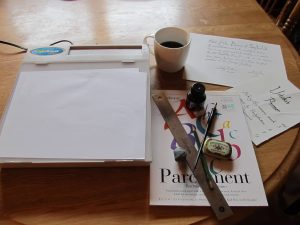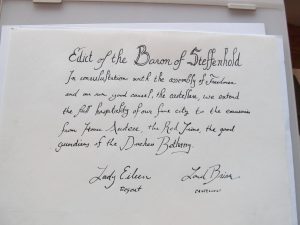The personal computer made preparing game handouts easy. Type something up, download and apply a nifty typeface, print it out and present it at the appropriate moment. All good.
But there’s something ineffable about doing a handout by hand. The homemade quality – the craftiness – can put a stamp on your on game.
Adding a touch of calligraphy is one way to do this. Here’s the materials I have at hand:
You can buy a stylus and pair of nibs for around $5. The ink is a little pricey, and even a small bottle will start out around $5. But it lasts for a long time if used judiciously.
Some folks, I know, like to add some authenticity by using regular paper, then staining it with coffee and heating in the oven to create the crinkled, ancient look, which is a fine thing to do. I prefer to drink my coffee, however, so the $6 for a tablet of parchment paper is worth it.
The other things you probably have laying around: a pencil and a straight-edge to draw guidelines on your paper, and an eraser for removing those lines. (I prefer a kneeded eraser, only because it doesn’t leave shavings, but your mileage may differ).
Now I happen to have a light table for other purposes, but it works wonders here because I can put ruled paper beneath the document I’m working on. This saves me the time of having to draw my own guidelines. It also provides a nice writing surface to work on.
Now here’s the beauty of “calligraphy.” Yes, there are many books and guidelines on how to do very stylistic letters in the Roman, Unical, Copperplate, Black Letter and Chancery formats. And if you want to take the time to learn those and apply them, that’s wonderful. (Just do a web search for those terms and you’ll have plenty of examples at the ready).
But basically, “calligraphy” is just writing. Remember that cursive script you had to do as a grade schooler? (As I recall, Lisa B. had the best penmanship in my class). Well, that’s more than serviceable for handout being prepared by you for your game table.
Here’s a couple I did. One is the first page of a sought-after book of enchantment spells that’s been making its way around the environs of Steffenhold (my homebrew world) for some time now. My players know of the tome – “Vitolo’s Primer” – as the “White Book.”
The other is a simple edict issued by the baron of Steffenhold granting hospitality and privilege to a squad of knights known as the Red Lions, which is loyal to the Duchess Bethany. Players would note that the document was not signed by the baron, but by his daughter-in-law and the castellan. What does that portend, I wonder? (Well, as GM, I don’t have to wonder, but the players might.)
The beauty of a handout in roleplaying games has always been their two-fold effectiveness. One, it gives the players a tangible entry into the scenario, an opportunity for immersion. Secondly, it’s a souvenir, something the players can take away from the playing session. Hopefully, it’s a good memory, and one that will prompt their return to the table for even more adventures.
Have you had any experience with calligraphy? Do handouts work in your games? Do have have a story about a favorite handout? Please share below.




















I’ve long been of the opinion that cursive script is a worthless art that they shouldn’t waste my child’s time teaching (and I know there are other people who feel very strongly otherwise. That’s cool. I’m not trying to start an argument about it.) so it’s nice to see a use for it other than signing one’s name.
Just yesterday I saw on Yahoo that a bank robbery was foiled because the bank robber’s note was not legible. The teller refused to cooperate because she couldn’t read the note. The robber gave up and left. So, you see, your grade school teachers were correct: penmanship does count.
As a matter of fact, not only have I used regular cursive in black India ink, I’ve used calligraphic “illuminations” for items for the gaming table. I made a book for the players – basically a tome for them to peruse that gave them info I wanted them to have, without me talking for thirty minutes. It wasn’t all that hard for me to do – but I must say, I’m always fiddling with some craft project or other, and having the materials handy and the know-how on how to construct a book helped a lot.
I have also played with colored inks and various effects – making a note illegible because of splatters of “blood,” making signatures that are the equal of any doctor’s scrawl, even one memorable letter from a baron’s daughter that involved purple ink. With hearts in place of the dots over every i.
You can have lots of fun with it 🙂
Penmanship is never a waste of time. Ever. If nothing else it will pay dividends if your child ever wants to make their own font. But think bigger: what if that child becomes an author, a best-selling one. She’s going to need a spiffy-looking signature for writing inside those books at a public signing (where rubber stamps or stickers run off on a laser printer tend to be viewed with hostility).
I lack the time to develop enough skill to produce caligraphic documents by hand, and for the same outlay cited for materials I can obtain a gazillion fonts for my computer.
Tea is better for fake documents than coffee, but both will make your ink run unless you print with a laser.
A toaster oven works well for heat-aging (and will make documents realistically brittle too) but you must take things slowly and open the windows. And never take your eyes off the document that’s cooking.
For a great aged look start by folding up the printed document and carefully burning just the outer edges of the paper (not the folds) with a flame (OUTSIDE!), extinguishing the flames before they get a hold and crumbling the burned bits off by hand before you grill.
All work best if you have a few days lead time to allow the burned smell to dissipate from the paper.
I once produced a “300 year old” deed for a Call of Cthulhu game this way, and when it began to crumble in a player’s hands he uttered an involuntary (and very gratifying) “Oh sweet!”
Thanks for sharing those stories. Great suggestions for any GM. Any others out there?
I agree, players really appreciate the handmade- even on a more simple level. I’m running a campaign set in mid 19th Century London – I printed a map of the area, and coloured in the river and the parklands. It also means that we can write on the map, marking in areas, NPCs homes and business etc. I think the players appreciate the handmade a lot more than simply buying something.
For burnt effect, an electric stove works great. You can press the paper and just burn away the parts you don’t want.
Old books are great props and materials. My school used to have some kind of donation table for ancient books. I got a copy of The Odyssey from the early 1900s. If you find a worthless book (not saying books are actually worthless, but the value is low) then you can add in bits of information you want the players to have. Even adding in an index card here and there with information would be better for immersion than telling the players.
I do a bit of wood carving and wood burning. If you have a fair hand, you can use that and a simple piece of paper to get that same scarred or charred edges look. I’ve also used that skill to make a homemade battle board with hexes on one side and squares on the other.
Quick question: how does slightly tea-aged paper do in an inkjet printer? As in, aging it first, then trying to print on it?
@Razjah – Absolutely! I used to have a pile of late 20s/early 30s books on the table and on nearby shelves during my Call of Cthulhu games. Anyone who cared to could check a fact in a period encyclopedia or text book. Can’t beat that for realism and immersion experience.
@Tsenn – Only do this if you can dismantle the printer. Reloading paper is a recipe for paper jams on steroids and I lost a new “both sides” capable wireless printer/fax/scanner to a family member loading cheap paper in it. Lost as in “completely wrecked”.
You would be better printing with a laser at Kinko’s, then doing the cold tea boogie.
As a left-hander, all that would happen is everything would get smudged.
I’d rather players have something legible and I not have an inkstain down the length of my hand.
An inkstain is a badge of honor. 🙂
@Troy E. Taylor – I saw The Name Of The Rose. An inkstain is the mark of someone about to be dead.
@Roxysteve – And I even wet the tip of my finger to turn my web pages … I’m doomed!